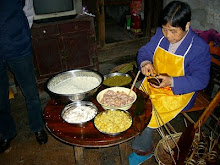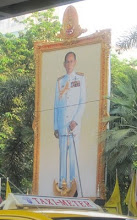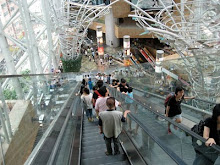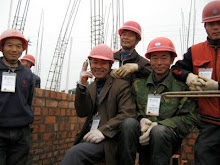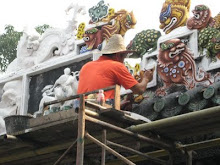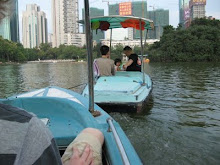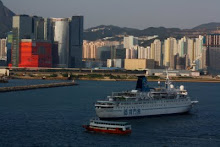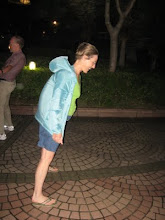The question is, where do you draw the line between what constitutes food and something you would not put in your mouth in a million years? The Chinese predilection for chicken feet is well known and we have had our share since we have been here. But in Beijing, we decided to take it to another level and visited a market well known for its interesting food. Some things we could recognize, but others were a mystery. But then we were fortunate in finding one of the stall owners who spoke a little English and was very happy to proudly show us all he had available. So we started at his stall and asked for silkworm larvae, scorpion, dog meat and sheep penis. Does that sound like a tasty meal or what! The sheep penis was the surprise on the menu, but there they were, anatomically unmistakable, butterflied and threaded onto a stick. Actually, everything was threaded onto a stick, so that we would never have known the dog was dog if we had not been told. Tasted like chicken, of course, but looked more like little pieces of pork. We wondered about the scorpion tail and whether the venom would survive the cooking process. We ended up breaking off the very tip, just in case.
The method of cooking at this stall was the same in all cases - throw them in the deep fryer, which I appreciated from a food safety point of view. It rendered everything small crunchy. So, if you want to know what a scorpion tastes like, I could tell you its similar to silk worm larvae and both are very crunchy, without having a lot of other flavor. The sheep penis was perhaps a little tougher than other cuts of lamb.
So what could we find to top that? Not much, it turned out. Next we tried a starfish. Surprisingly, that was only shallow fried and it was the only disappointment of the day. The outside was fairly tough and fibrous and only a little crunchy. Inside it was softer, definitely nautical tasting, but not particularly appetizing. It was the only thing that we didn't actually finish. We, in this case, primarily meant Jacob and I. Duncan was the official photographer, although he has a taste of most things, even bending his vegetarian principles for the experience. Elizabeth came along for the ride, but her role was mostly restricted to providing sound effects and expressions of disgust.
We moved on to grasshopper and centipede. The grasshopper would definitely get my vote out of those two. Once the centipede had been deep fried, it was kind of difficult to get it off its stick - or even to tell it apart from its stick. The grasshoppers, on the other hand, better maintained their integrity and provided one of the most pleasant crunches of the meal.
If food and/or protein is in limited supply then the definition of what constitutes food tends tends to get expanded. You can introduce whole new species, as in the Beijing market, but more commonly for meat it means using all parts of the animal. Why just eat the muscle when you have all the organs available? When I was in the market in Mai Chau in Vietnam, I saw very little of the kind of meat that Westerners are accustomed to, and a whole lot more liver, intestines, lungs, skin and feet. We had lunch at HK University of Science and Technology this week and were presented with a dish of fish bladder. I tried it and was wondering if I could still taste any urine, until it was pointed out that this was a gas bladder, used for flotation purposes. That made it taste a whole lot better. It was off white, with a pleasant spongy texture and relatively subtle fishy taste. Chinese people really like it and consider it to be good for the skin. I realized that I have seen it in the fish market all the time without understanding what it was.
Saturday, January 23, 2010
Tuesday, January 19, 2010
So after Vietnam came China. And one of the most interesting things about China was that our major mode of transportation was the China Railways system. The trip was made complex by the bizarre booking system of this system, or should I say the lack of a booking system. You can only buy tickets in the city of departure. So our trip was HK to Guangzhou to Xi'an to Beijing to HK. The first leg was just a 2 hour trip that we have done before. We then took the subway across Guangzhou because the Xi'an train left from a different station. Only then could we buy the tickets for the Xi'an train. After some effort we discovered that the Chinese system is to have the ticket-booking hall in a separate building adjacent to the station. Upon entering, we were met by this vast sea of humanity, roughly organized into lines in front of the 20 or so windows. Careful examination of these revealed the one window staffed by an English speaker. That was the line to join. After waiting our turn, we asked for 5 hard sleeper berths to Xi'an. They were available (fortunately - they often sell out and this train only goes once a day), though not in the same compartment. But we took them and then tried to find our way into the station itself. Basically, it was follow the crowd, through the security lines and into this behemoth of a station that was so overrun with humanity that it made the booking hall look like a quiet dinner for two.
We thought that we would find several restaurants in there for lunch but unfortunately, there were only two, both fast food, one Chinese and one KFC. That explained why there were so many people selling food outside the station, but once inside there was no going back. I figured out where we were supposed to wait for our particular train and joined the hoard there. I noticed enviously that people who had soft sleeper tickets had their own waiting room and even better, a tea room. From time to time they would make announcements in our waiting room, entirely in Cantonese of which we understood not a word. So we just tried to behave like everybody else and line up in the appropriate places. It was kind of funny, we were all lined up at one end of the room, with us at the back, when a new announcement caused everybody to rush to the other end of the room. That meant we were much closer to the front and that was the end from which they started boarding the train. It was all rather mysterious to me because, as far as I know, everybody had an assigned bed or seat on the train and therefore it really did not matter when people boarded.
We found our hard sleeper berths, in two adjacent compartments. They are arranged in bays of 2x3 beds, with the top one not having too much space. Actually they charge less money for the higher ones also. There are no doors on these compartments so they all open directly on the corridor. Thus, we shared the next 25 hours, very intimately with the other people in our compartments, but in the same small world as everybody in our train carriage. There were two women in the bottom beds of my compartment with a very young baby. Elizabeth though neither of them looked like they had just given birth, thus we surmised adoption. Actually, when I woke up the next morning they had all gone, so we had a lot more space. I spent a lot of time sitting in the corridor and watching life come and go. There were many vendors of food. The food was very good, much better than you would encounter on a British or US train, and reasonably priced. You could also buy all sorts of other stuff - my favorite was a necklace that offered all sorts of protections, most notably against radiation damage.
The trip from Guangzhou to Xi'an takes 25 hours. We left at 3 and got in around 4 the next afternoon. The passing landscape was mostly unremarkable, with occasional interludes; many different kinds of houses, lots of big cities, a few mountains here and there. I saw very little unused space. Land without buildings usually had something planted on it. Visibility was often limited by haze. Maybe it was just the weather, but more likely it was pollution. Sometime there was a touch of the Lorax about it.
I did not see any other Westerners on that train - there were lots on the Beijing to HK trip. Jacob in particular had a very nice interaction with some people in the next compartment. I can't remember how it started, but it morphed into an extended language lesson, with most of the benefit coming in our direction.
We had soft sleepers for both of the other long train rides. Not for the nicer waiting rooms but rather because the hard sleepers were all sold out. They were very nice but meant more privacy and therefore greater separation from the other passengers. Duncan really appreciated the soft sleepers. He had been on the very top bunk in the hard sleepers. They control the lights and the PA system centrally for the whole carriage and he was woken up at 7 AM by a bright fluorescent light about a foot from his face. On the trip back to HK I woke him about 10.30 when I was fed up with waiting for the rolls we had bought for breakfast.
Every train carriage comes equipped with a supply of near boiling water and each compartment, both hard and soft, comes with a thermos flask that can be filled with this hot water and then used to make tea. The soft sleepers even come with nice mugs with lids to facilitate that process. Is that civilized or what!
We thought that we would find several restaurants in there for lunch but unfortunately, there were only two, both fast food, one Chinese and one KFC. That explained why there were so many people selling food outside the station, but once inside there was no going back. I figured out where we were supposed to wait for our particular train and joined the hoard there. I noticed enviously that people who had soft sleeper tickets had their own waiting room and even better, a tea room. From time to time they would make announcements in our waiting room, entirely in Cantonese of which we understood not a word. So we just tried to behave like everybody else and line up in the appropriate places. It was kind of funny, we were all lined up at one end of the room, with us at the back, when a new announcement caused everybody to rush to the other end of the room. That meant we were much closer to the front and that was the end from which they started boarding the train. It was all rather mysterious to me because, as far as I know, everybody had an assigned bed or seat on the train and therefore it really did not matter when people boarded.
We found our hard sleeper berths, in two adjacent compartments. They are arranged in bays of 2x3 beds, with the top one not having too much space. Actually they charge less money for the higher ones also. There are no doors on these compartments so they all open directly on the corridor. Thus, we shared the next 25 hours, very intimately with the other people in our compartments, but in the same small world as everybody in our train carriage. There were two women in the bottom beds of my compartment with a very young baby. Elizabeth though neither of them looked like they had just given birth, thus we surmised adoption. Actually, when I woke up the next morning they had all gone, so we had a lot more space. I spent a lot of time sitting in the corridor and watching life come and go. There were many vendors of food. The food was very good, much better than you would encounter on a British or US train, and reasonably priced. You could also buy all sorts of other stuff - my favorite was a necklace that offered all sorts of protections, most notably against radiation damage.
The trip from Guangzhou to Xi'an takes 25 hours. We left at 3 and got in around 4 the next afternoon. The passing landscape was mostly unremarkable, with occasional interludes; many different kinds of houses, lots of big cities, a few mountains here and there. I saw very little unused space. Land without buildings usually had something planted on it. Visibility was often limited by haze. Maybe it was just the weather, but more likely it was pollution. Sometime there was a touch of the Lorax about it.
I did not see any other Westerners on that train - there were lots on the Beijing to HK trip. Jacob in particular had a very nice interaction with some people in the next compartment. I can't remember how it started, but it morphed into an extended language lesson, with most of the benefit coming in our direction.
We had soft sleepers for both of the other long train rides. Not for the nicer waiting rooms but rather because the hard sleepers were all sold out. They were very nice but meant more privacy and therefore greater separation from the other passengers. Duncan really appreciated the soft sleepers. He had been on the very top bunk in the hard sleepers. They control the lights and the PA system centrally for the whole carriage and he was woken up at 7 AM by a bright fluorescent light about a foot from his face. On the trip back to HK I woke him about 10.30 when I was fed up with waiting for the rolls we had bought for breakfast.
Every train carriage comes equipped with a supply of near boiling water and each compartment, both hard and soft, comes with a thermos flask that can be filled with this hot water and then used to make tea. The soft sleepers even come with nice mugs with lids to facilitate that process. Is that civilized or what!
Tuesday, January 12, 2010
We spent Christmas in Vietnam. Not exactly a hotbed of Christianity, although the French influence has left some churches in Hanoi. We thought it might be nice to escape the rank commercialism that is Christmas in Hong Kong, and indeed it was, although vestiges remained. We saw several Santa-suited bikers on the streets of Hanoi. We went out to dinner on Xmas eve with another Fulbright family from HK. We ate at a relatively up-market restaurant and were greeted there by a Santa. Except that he was a little half-hearted. His beard was pathetic and he was only wearing the top half of the costume. But once we were seated, he came and gave us all a present, attractively packaged in a brown paper bag. Inside was a pair of white cotton tube socks. Everybody got the same adult size, which particularly bemused the young children present. But the food was good and that represented our main Christmas meal. Christmas day itself found us being driven about 4 hours to Halong Bay.
Given limited time and no knowledge, we had opted for a package tour in Vietnam. Buffalo Tours - I would highly recommend them if you want to go to Indochina. So they were taking us to Halong Bay and our small cruise boat that was going to take us around there. HB is one of those breathtakingly beautiful places and a UNESCO World Heritage site. It has these limestone casts that form islands, mostly small rising abruptly out of the waters of the bay. I think there are about 1000 islands in a pretty large bay. It's so gorgeous that everybody wants to go there and so there about 100 boats like ours, cruising the waters. For the most part, there was plenty of room for everybody, although when we visited the caves, we had to wait to get to the dock. I even went kayaking, an unusual event for a landlubber like me, but that way we could get to otherwise inaccessible places. Our boat had 15 passengers and very good food, a good portion of which had come out of the bay.
Actually, Vietnam was good from a culinary perspective, since the other place we went was about the same distance west of Hanoi, Mai Chau, which is up in the hill country. We stayed at a resort there, which catered to us very nicely. It was a small town, surrounded by several small villages, set on a flat plain between two ranges of hills. Quite misty when we were there and also very beautiful. I walked between the rice paddies, which were terraced, though absent of rice since they were between crops. The villages are set up to sell handicrafts to tourist like us, lots of gorgeous scarves and embroideries. We got to enter one house, which belonged to the grandfather of our guide. It was set up on stilts, basically post and beam construction, with a thatched roof and bamboo floor. Large, open, simple and elegant. We did not meet the grandfather, though I would have liked to do so. He had his war medals on the wall and his picture taken with Ho Chi Minh. Next to that was a frame containing 5 photos - Ho, Marx, Engels, Lenin and Stalin. Elizabeth sometimes found it a little difficult being in Vietnam because of the history, but that aspect did not bother me.
Back in Hanoi we went to visit Ho Chi Minh's tomb and the buildings in which he lived. He started off in a colonial palace but then moved quickly on to a smaller building nearby. But he spent most time in a much smaller two storey, four room building that was very simple and beautiful. Seeing his body was interesting. You have to go through all sorts of security and then march up to it two by two. He looks like he died yesterday. People there really seem to like Uncle Ho and see him as a real hero.
Hanoi was a trip. Six million people and 4 million motorized two-wheelers of various kinds, though mostly with pretty small engines. They are used for multiple transport functions. Seeing them carry families of 4 was common, as were livestock (pigs or chickens) and enormous and apparently precarious loads. Would you fell comfortable transporting your new, large, flat screen TV on a motor scooter? There were some cars, lots of taxis and very few buses - public transport is not one of the major achievements of this socialist state. I am a very proficient urban pedestrian and crossing the street in Hanoi required all of my skills. Vehicles take traffic lights as suggestions, rather than commands, and traffic lanes and right of way are alien concepts. But it all seems to work. Although sometimes it felt that were we risking our lives while being driven places, I never saw an accident. Drivers seem to be able to predict the behavior of others and also judge distances very well.
Given limited time and no knowledge, we had opted for a package tour in Vietnam. Buffalo Tours - I would highly recommend them if you want to go to Indochina. So they were taking us to Halong Bay and our small cruise boat that was going to take us around there. HB is one of those breathtakingly beautiful places and a UNESCO World Heritage site. It has these limestone casts that form islands, mostly small rising abruptly out of the waters of the bay. I think there are about 1000 islands in a pretty large bay. It's so gorgeous that everybody wants to go there and so there about 100 boats like ours, cruising the waters. For the most part, there was plenty of room for everybody, although when we visited the caves, we had to wait to get to the dock. I even went kayaking, an unusual event for a landlubber like me, but that way we could get to otherwise inaccessible places. Our boat had 15 passengers and very good food, a good portion of which had come out of the bay.
Actually, Vietnam was good from a culinary perspective, since the other place we went was about the same distance west of Hanoi, Mai Chau, which is up in the hill country. We stayed at a resort there, which catered to us very nicely. It was a small town, surrounded by several small villages, set on a flat plain between two ranges of hills. Quite misty when we were there and also very beautiful. I walked between the rice paddies, which were terraced, though absent of rice since they were between crops. The villages are set up to sell handicrafts to tourist like us, lots of gorgeous scarves and embroideries. We got to enter one house, which belonged to the grandfather of our guide. It was set up on stilts, basically post and beam construction, with a thatched roof and bamboo floor. Large, open, simple and elegant. We did not meet the grandfather, though I would have liked to do so. He had his war medals on the wall and his picture taken with Ho Chi Minh. Next to that was a frame containing 5 photos - Ho, Marx, Engels, Lenin and Stalin. Elizabeth sometimes found it a little difficult being in Vietnam because of the history, but that aspect did not bother me.
Back in Hanoi we went to visit Ho Chi Minh's tomb and the buildings in which he lived. He started off in a colonial palace but then moved quickly on to a smaller building nearby. But he spent most time in a much smaller two storey, four room building that was very simple and beautiful. Seeing his body was interesting. You have to go through all sorts of security and then march up to it two by two. He looks like he died yesterday. People there really seem to like Uncle Ho and see him as a real hero.
Hanoi was a trip. Six million people and 4 million motorized two-wheelers of various kinds, though mostly with pretty small engines. They are used for multiple transport functions. Seeing them carry families of 4 was common, as were livestock (pigs or chickens) and enormous and apparently precarious loads. Would you fell comfortable transporting your new, large, flat screen TV on a motor scooter? There were some cars, lots of taxis and very few buses - public transport is not one of the major achievements of this socialist state. I am a very proficient urban pedestrian and crossing the street in Hanoi required all of my skills. Vehicles take traffic lights as suggestions, rather than commands, and traffic lanes and right of way are alien concepts. But it all seems to work. Although sometimes it felt that were we risking our lives while being driven places, I never saw an accident. Drivers seem to be able to predict the behavior of others and also judge distances very well.
Subscribe to:
Comments (Atom)










